Enhancing positive effects for the communicative+ language teaching activities in English classrooms
Nowadays, most English teachers have widely applied the Communicative Language Teaching
activities (the CLT activities) in English classrooms as a foreign language (EFL) because of their
outstanding effectiveness. In spite of having many benefits for learning and teaching English,
activities in CLT also have problems with mixed-level students, un-motivated students and large class
sizes, as well as lack of language environment for foreign language acquisition. This article is about
how to enhance the positive effect for the CLT activities by using technology equipment. In this
article, the author reviews the crucial theory of the improvement effects for the CLT activities, and
therefrom practical activities are designed to teach English speaking skills.
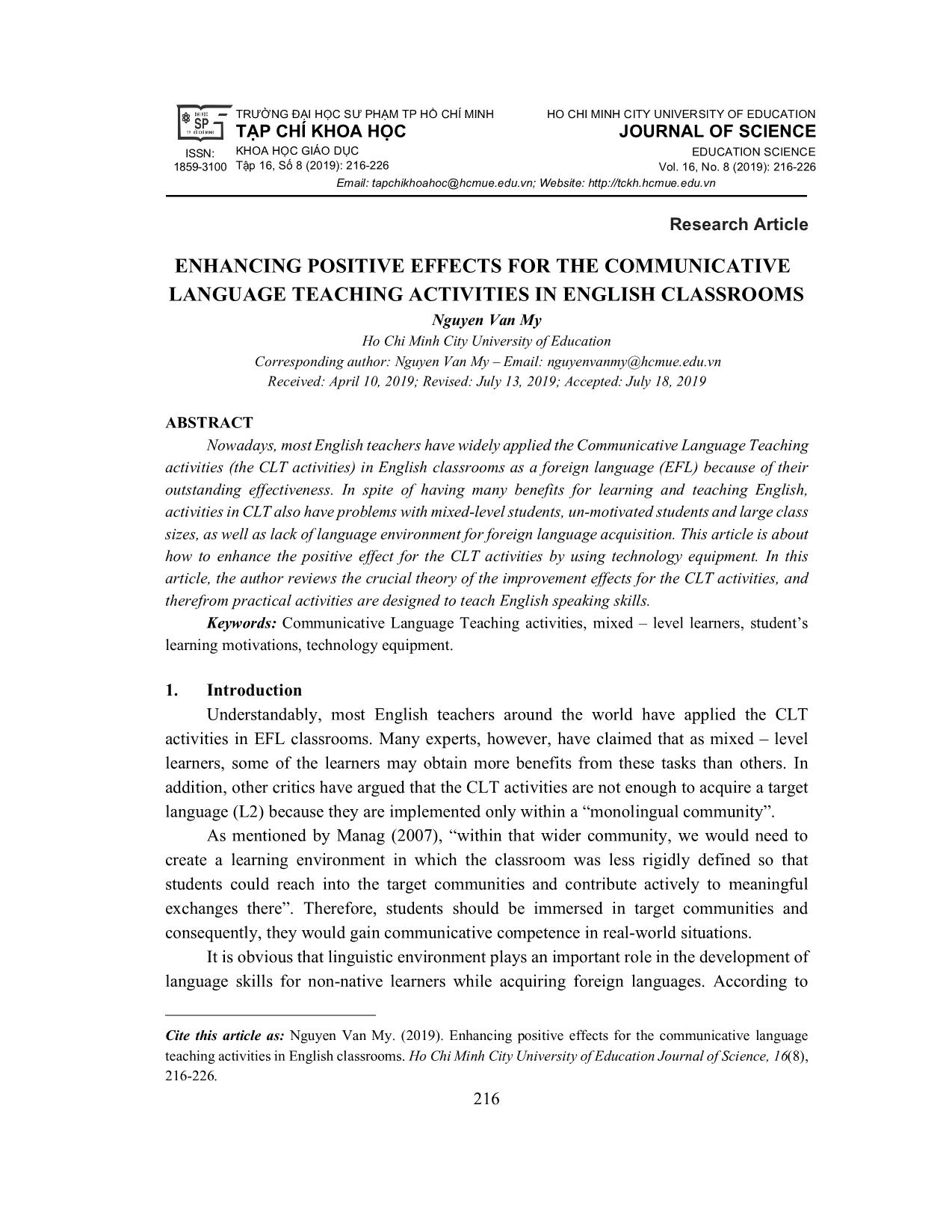
Trang 1
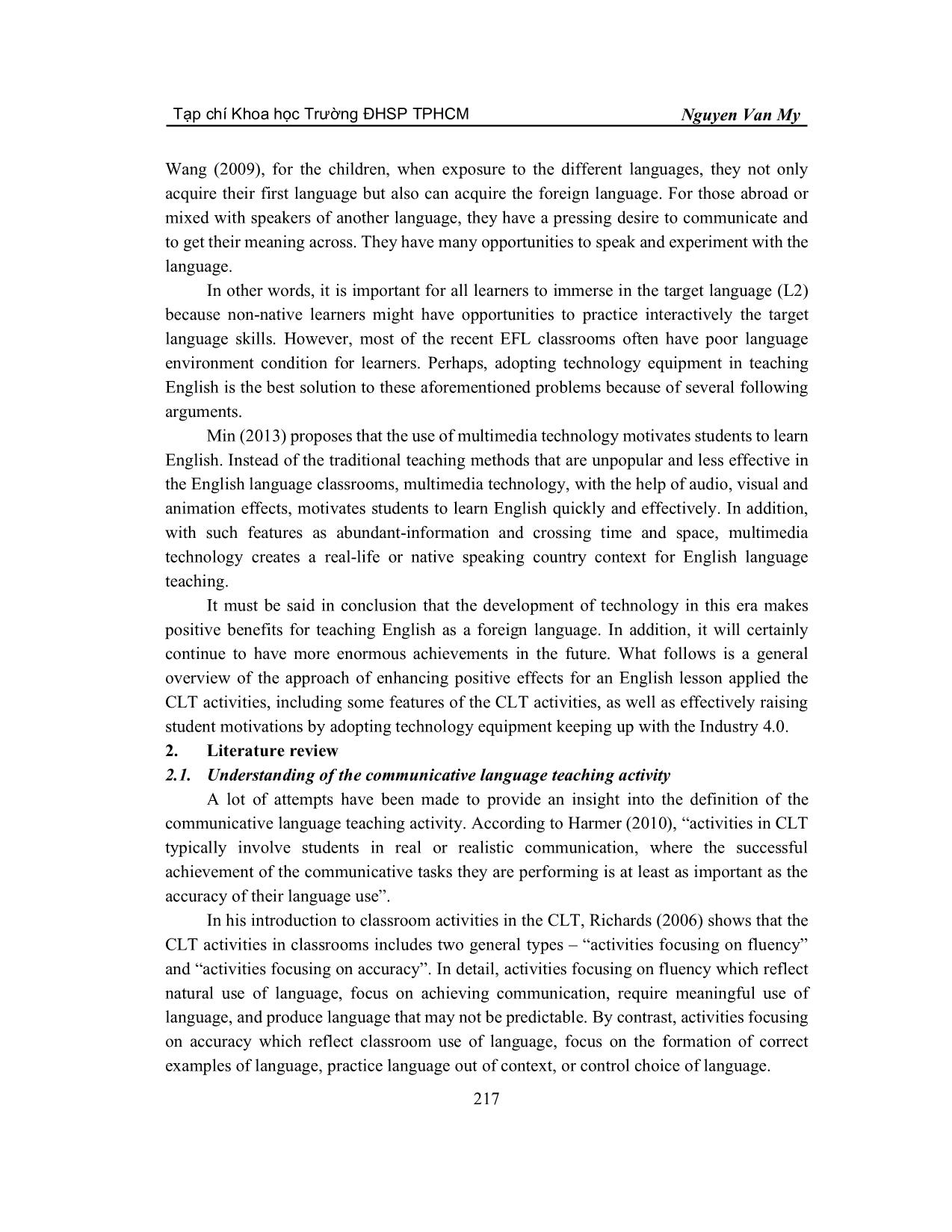
Trang 2
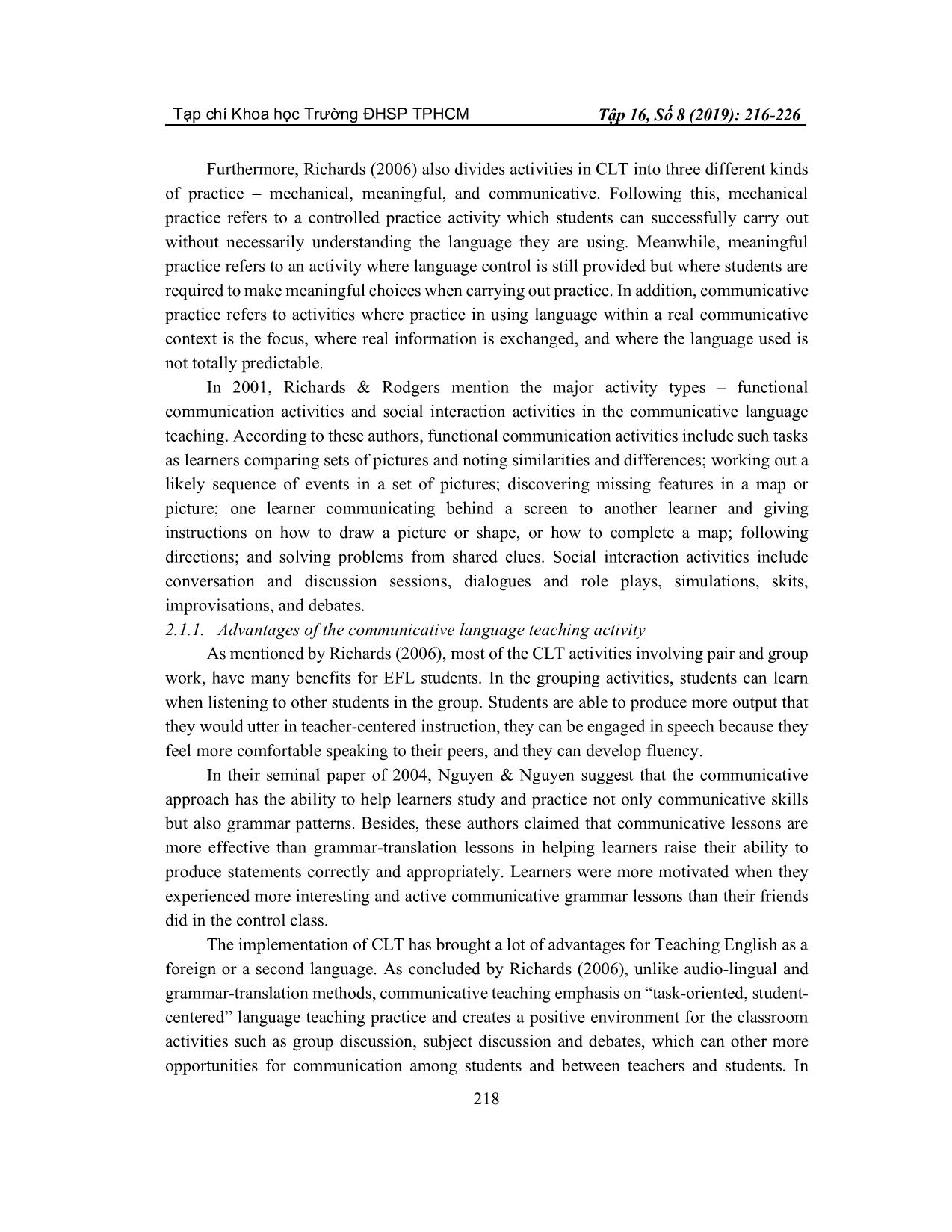
Trang 3
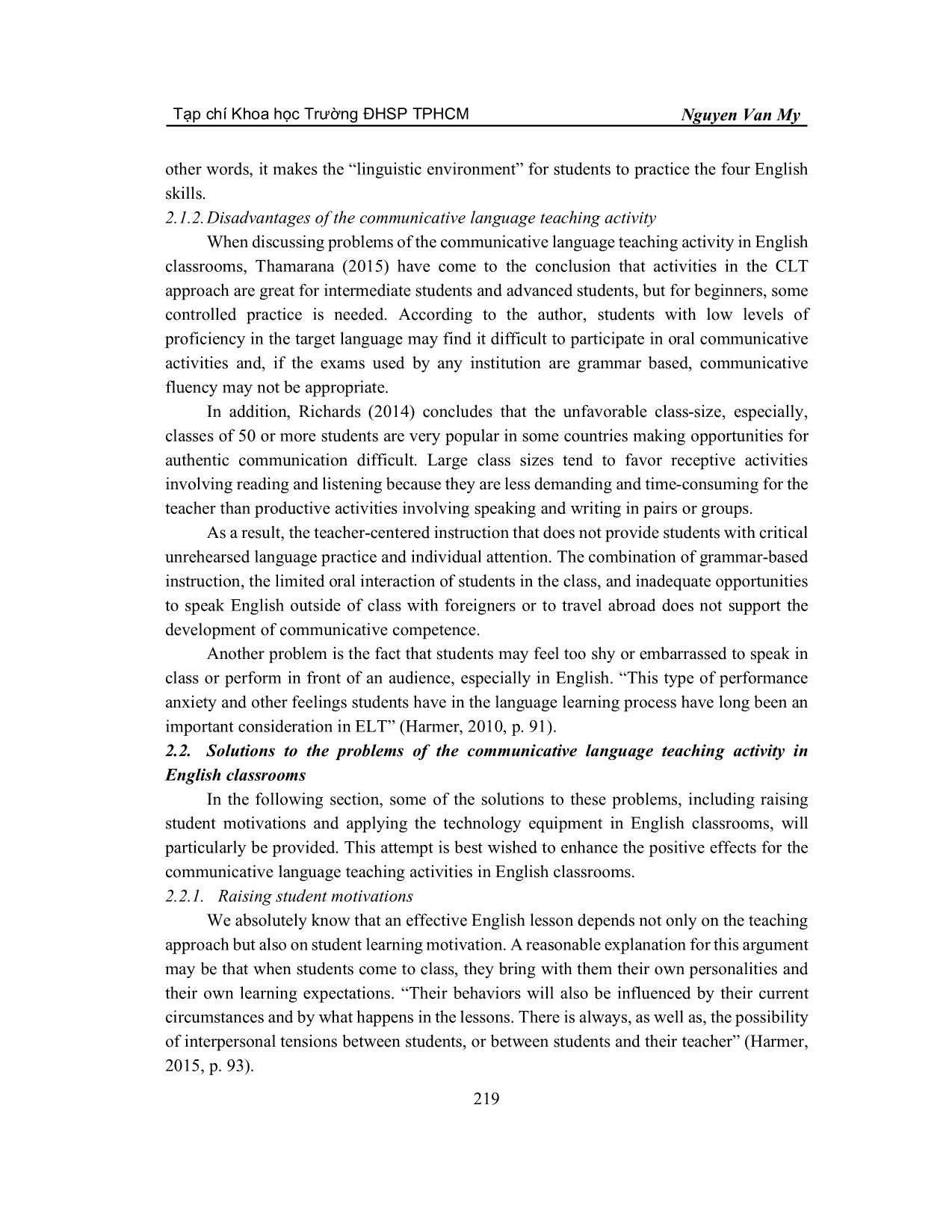
Trang 4
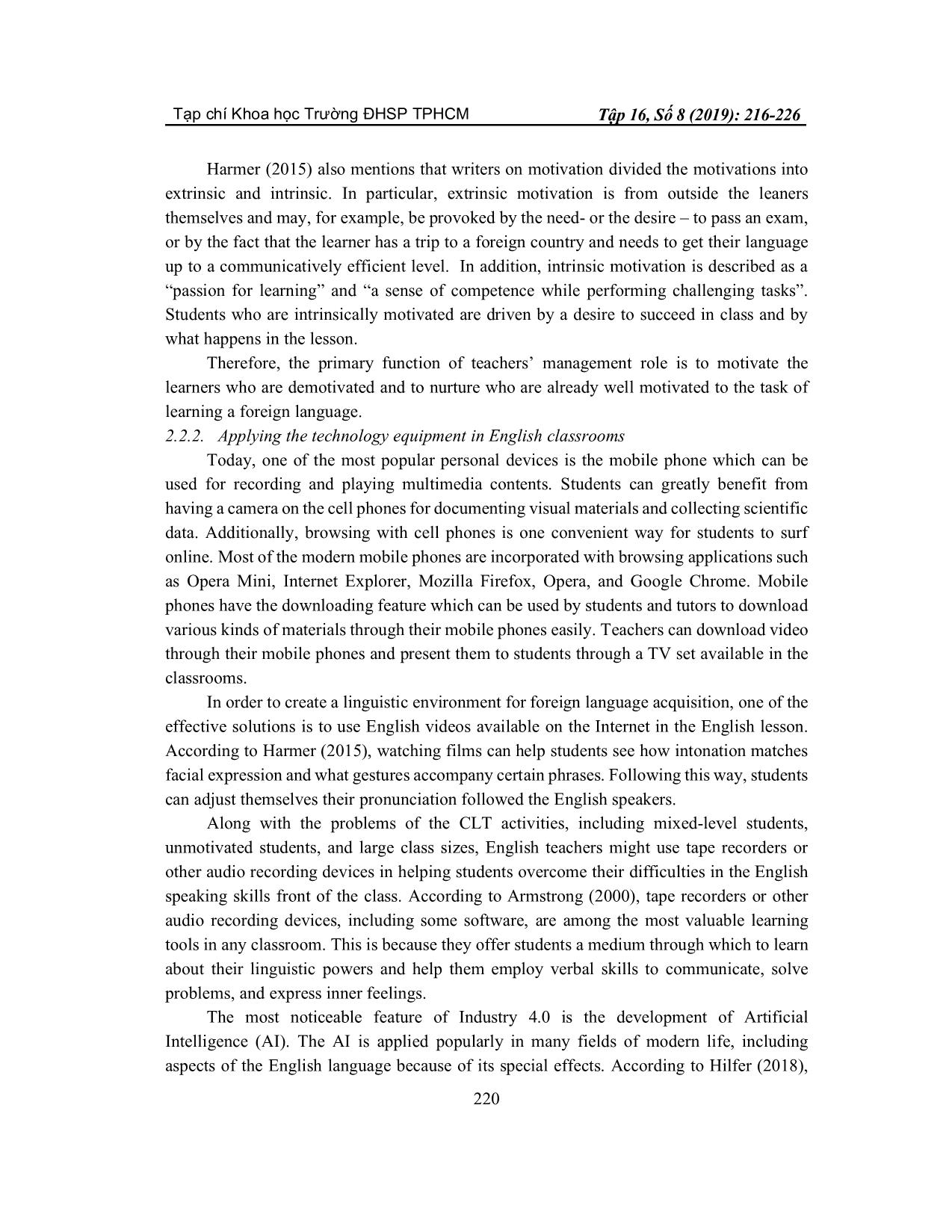
Trang 5
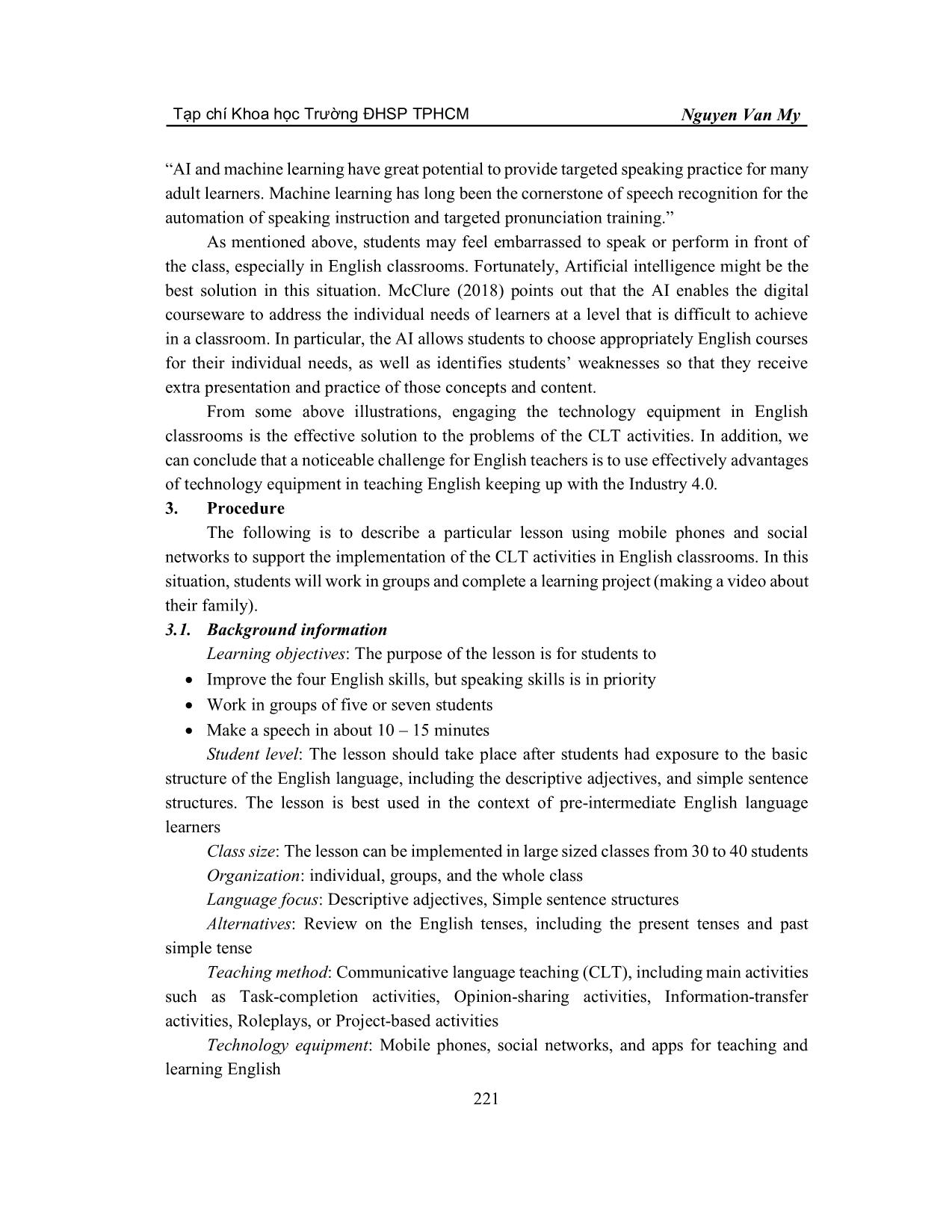
Trang 6
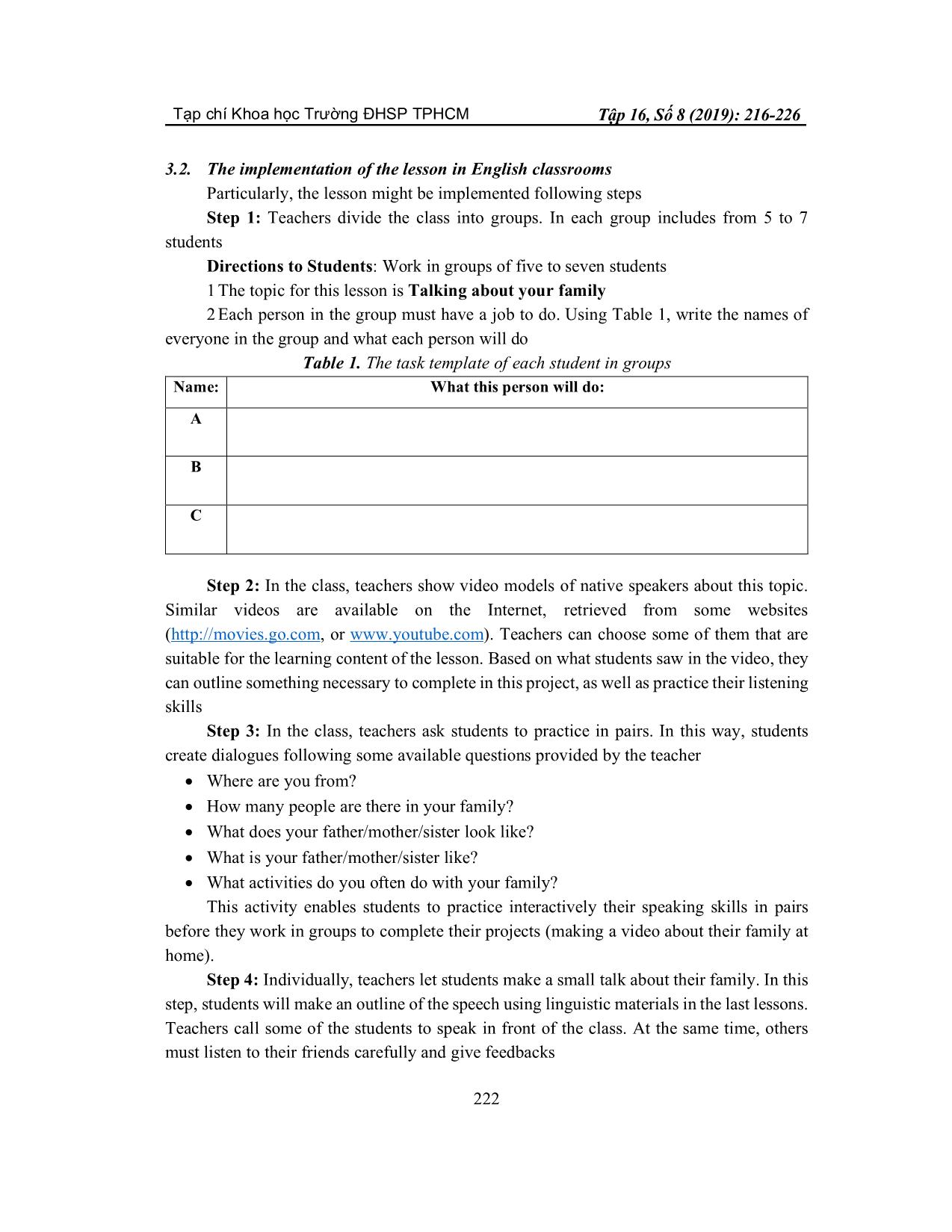
Trang 7
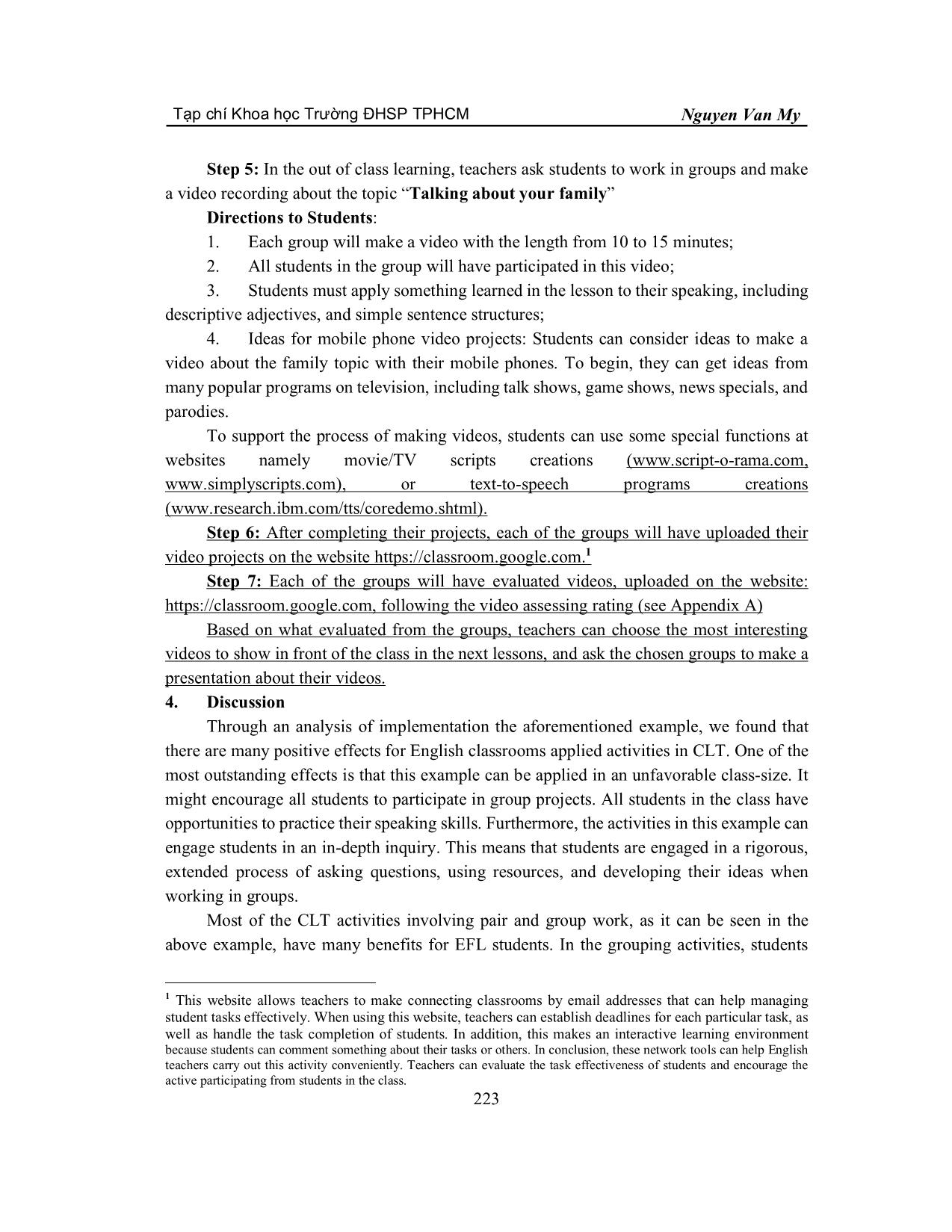
Trang 8

Trang 9
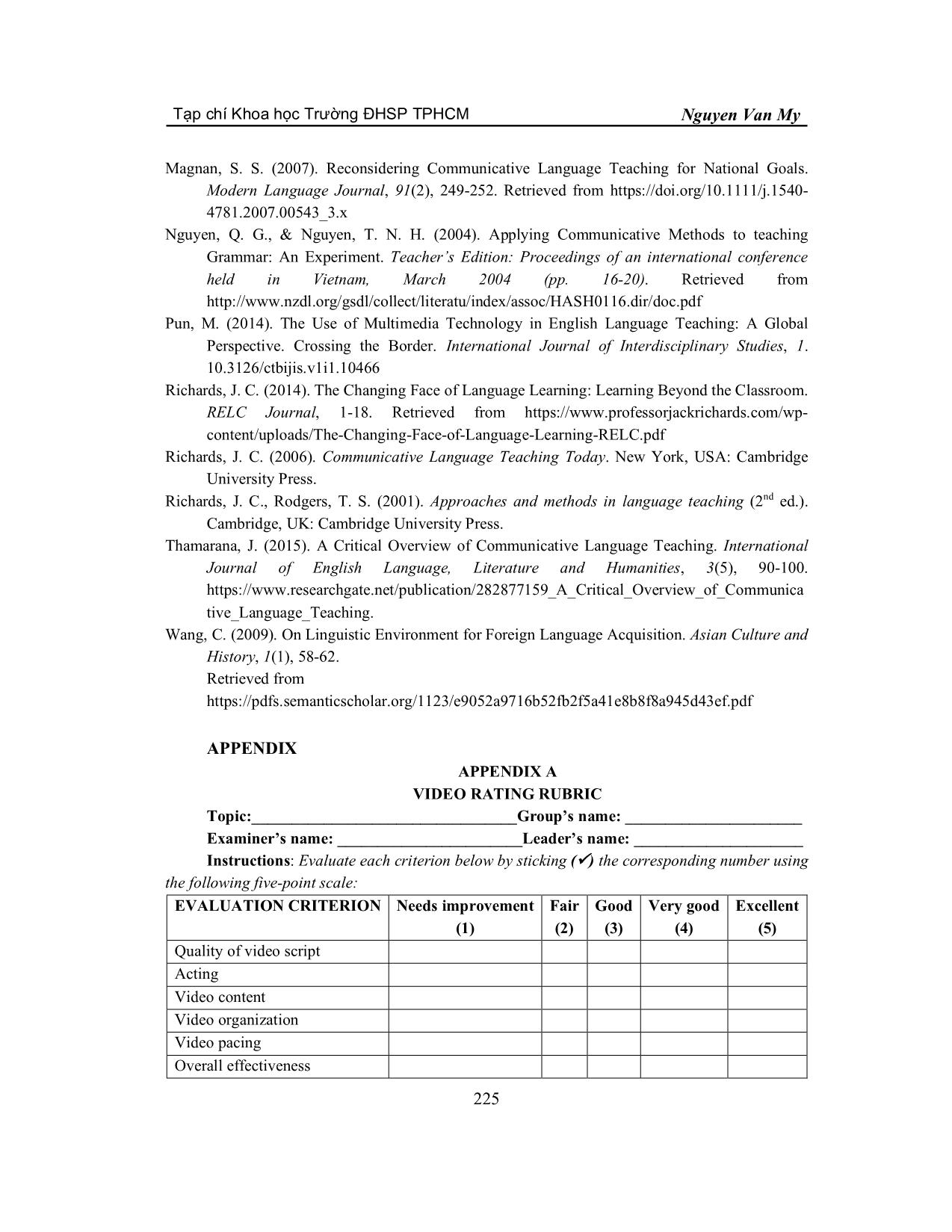
Trang 10
Tải về để xem bản đầy đủ
Tóm tắt nội dung tài liệu: Enhancing positive effects for the communicative+ language teaching activities in English classrooms
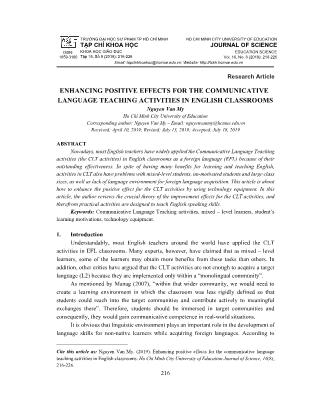
TRƯỜNG ĐẠI HỌC SƯ PHẠM TP HỒ CHÍ MINH TẠP CHÍ KHOA HỌC HO CHI MINH CITY UNIVERSITY OF EDUCATION JOURNAL OF SCIENCE ISSN: 1859-3100 KHOA HỌC GIÁO DỤC Tập 16, Số 8 (2019): 216-226 EDUCATION SCIENCE Vol. 16, No. 8 (2019): 216-226 Email: tapchikhoahoc@hcmue.edu.vn; Website: 216 Research Article ENHANCING POSITIVE EFFECTS FOR THE COMMUNICATIVE+ LANGUAGE TEACHING ACTIVITIES IN ENGLISH CLASSROOMS Nguyen Van My Ho Chi Minh City University of Education Corresponding author: Nguyen Van My – Email: nguyenvanmy@hcmue.edu.vn Received: April 10, 2019; Revised: July 13, 2019; Accepted: July 18, 2019 ABSTRACT Nowadays, most English teachers have widely applied the Communicative Language Teaching activities (the CLT activities) in English classrooms as a foreign language (EFL) because of their outstanding effectiveness. In spite of having many benefits for learning and teaching English, activities in CLT also have problems with mixed-level students, un-motivated students and large class sizes, as well as lack of language environment for foreign language acquisition. This article is about how to enhance the positive effect for the CLT activities by using technology equipment. In this article, the author reviews the crucial theory of the improvement effects for the CLT activities, and therefrom practical activities are designed to teach English speaking skills. Keywords: Communicative Language Teaching activities, mixed – level learners, student’s learning motivations, technology equipment. 1. Introduction Understandably, most English teachers around the world have applied the CLT activities in EFL classrooms. Many experts, however, have claimed that as mixed – level learners, some of the learners may obtain more benefits from these tasks than others. In addition, other critics have argued that the CLT activities are not enough to acquire a target language (L2) because they are implemented only within a “monolingual community”. As mentioned by Manag (2007), “within that wider community, we would need to create a learning environment in which the classroom was less rigidly defined so that students could reach into the target communities and contribute actively to meaningful exchanges there”. Therefore, students should be immersed in target communities and consequently, they would gain communicative competence in real-world situations. It is obvious that linguistic environment plays an important role in the development of language skills for non-native learners while acquiring foreign languages. According to Cite this article as: Nguyen Van My. (2019). Enhancing positive effects for the communicative language teaching activities in English classrooms. Ho Chi Minh City University of Education Journal of Science, 16(8), 216-226. Tạp chí Khoa học Trường ĐHSP TPHCM Nguyen Van My 217 Wang (2009), for the children, when exposure to the different languages, they not only acquire their first language but also can acquire the foreign language. For those abroad or mixed with speakers of another language, they have a pressing desire to communicate and to get their meaning across. They have many opportunities to speak and experiment with the language. In other words, it is important for all learners to immerse in the target language (L2) because non-native learners might have opportunities to practice interactively the target language skills. However, most of the recent EFL classrooms often have poor language environment condition for learners. Perhaps, adopting technology equipment in teaching English is the best solution to these aforementioned problems because of several following arguments. Min (2013) proposes that the use of multimedia technology motivates students to learn English. Instead of the traditional teaching methods that are unpopular and less effective in the English language classrooms, multimedia technology, with the help of audio, visual and animation effects, motivates students to learn English quickly and effectively. In addition, with such features as abundant-information and crossing time and space, multimedia technology creates a real-life or native speaking country context for English language teaching. It must be said in conclusion that the development of technology in this era makes positive benefits for teaching English as a foreign language. In addition, it will certainly continue to have more enormous achievements in the future. What follows is a general overview of the approach of enhancing positive effects for an English lesson applied the CLT activities, including some features of the CLT activities, as well as effectively raising student motivations by adopting technology equipment keeping up with the Industry 4.0. 2. Literature review 2.1. Understanding of the communicative language teaching activity A lot of attempts have been made to provide an insight into the definition of the communicative language teaching activity. According to Harmer (2010), “activities in CLT typically involve students in real or realistic communication, where the successful achievement of the communicative tasks they are performing is at least as important as the accuracy of their language use”. In his introduction to classroom activities in the CLT, Richards (2006) shows that the CLT activities in classrooms includes two general types – “activities focusing on fluency” and “activities focusing on accuracy”. In detail, activities focusing on fluency which reflect natural use of language, focus on achieving communication, require meaningful use of language, and produce language that may not be predictable. By contrast, activities focusing on accuracy which reflect classroom use of language, focus on the formation of correct examples of language, practice language out of context, or control choice of language. Tạp chí Khoa học Trường ĐHSP TPHC ... ively advantages of technology equipment in teaching English keeping up with the Industry 4.0. 3. Procedure The following is to describe a particular lesson using mobile phones and social networks to support the implementation of the CLT activities in English classrooms. In this situation, students will work in groups and complete a learning project (making a video about their family). 3.1. Background information Learning objectives: The purpose of the lesson is for students to Improve the four English skills, but speaking skills is in priority Work in groups of five or seven students Make a speech in about 10 – 15 minutes Student level: The lesson should take place after students had exposure to the basic structure of the English language, including the descriptive adjectives, and simple sentence structures. The lesson is best used in the context of pre-intermediate English language learners Class size: The lesson can be implemented in large sized classes from 30 to 40 students Organization: individual, groups, and the whole class Language focus: Descriptive adjectives, Simple sentence structures Alternatives: Review on the English tenses, including the present tenses and past simple tense Teaching method: Communicative language teaching (CLT), including main activities such as Task-completion activities, Opinion-sharing activities, Information-transfer activities, Roleplays, or Project-based activities Technology equipment: Mobile phones, social networks, and apps for teaching and learning English Tạp chí Khoa học Trường ĐHSP TPHCM Tập 16, Số 8 (2019): 216-226 222 3.2. The implementation of the lesson in English classrooms Particularly, the lesson might be implemented following steps Step 1: Teachers divide the class into groups. In each group includes from 5 to 7 students Directions to Students: Work in groups of five to seven students 1 The topic for this lesson is Talking about your family 2 Each person in the group must have a job to do. Using Table 1, write the names of everyone in the group and what each person will do Table 1. The task template of each student in groups Name: What this person will do: A B C Step 2: In the class, teachers show video models of native speakers about this topic. Similar videos are available on the Internet, retrieved from some websites ( or www.youtube.com). Teachers can choose some of them that are suitable for the learning content of the lesson. Based on what students saw in the video, they can outline something necessary to complete in this project, as well as practice their listening skills Step 3: In the class, teachers ask students to practice in pairs. In this way, students create dialogues following some available questions provided by the teacher Where are you from? How many people are there in your family? What does your father/mother/sister look like? What is your father/mother/sister like? What activities do you often do with your family? This activity enables students to practice interactively their speaking skills in pairs before they work in groups to complete their projects (making a video about their family at home). Step 4: Individually, teachers let students make a small talk about their family. In this step, students will make an outline of the speech using linguistic materials in the last lessons. Teachers call some of the students to speak in front of the class. At the same time, others must listen to their friends carefully and give feedbacks Tạp chí Khoa học Trường ĐHSP TPHCM Nguyen Van My 223 Step 5: In the out of class learning, teachers ask students to work in groups and make a video recording about the topic “Talking about your family” Directions to Students: 1. Each group will make a video with the length from 10 to 15 minutes; 2. All students in the group will have participated in this video; 3. Students must apply something learned in the lesson to their speaking, including descriptive adjectives, and simple sentence structures; 4. Ideas for mobile phone video projects: Students can consider ideas to make a video about the family topic with their mobile phones. To begin, they can get ideas from many popular programs on television, including talk shows, game shows, news specials, and parodies. To support the process of making videos, students can use some special functions at websites namely movie/TV scripts creations (www.script-o-rama.com, www.simplyscripts.com), or text-to-speech programs creations (www.research.ibm.com/tts/coredemo.shtml). Step 6: After completing their projects, each of the groups will have uploaded their video projects on the website https://classroom.google.com.1 Step 7: Each of the groups will have evaluated videos, uploaded on the website: https://classroom.google.com, following the video assessing rating (see Appendix A) Based on what evaluated from the groups, teachers can choose the most interesting videos to show in front of the class in the next lessons, and ask the chosen groups to make a presentation about their videos. 4. Discussion Through an analysis of implementation the aforementioned example, we found that there are many positive effects for English classrooms applied activities in CLT. One of the most outstanding effects is that this example can be applied in an unfavorable class-size. It might encourage all students to participate in group projects. All students in the class have opportunities to practice their speaking skills. Furthermore, the activities in this example can engage students in an in-depth inquiry. This means that students are engaged in a rigorous, extended process of asking questions, using resources, and developing their ideas when working in groups. Most of the CLT activities involving pair and group work, as it can be seen in the above example, have many benefits for EFL students. In the grouping activities, students 1 This website allows teachers to make connecting classrooms by email addresses that can help managing student tasks effectively. When using this website, teachers can establish deadlines for each particular task, as well as handle the task completion of students. In addition, this makes an interactive learning environment because students can comment something about their tasks or others. In conclusion, these network tools can help English teachers carry out this activity conveniently. Teachers can evaluate the task effectiveness of students and encourage the active participating from students in the class. Tạp chí Khoa học Trường ĐHSP TPHCM Tập 16, Số 8 (2019): 216-226 224 can learn when listening to other students in the group. Additionally, students can develop 21st-century skills, students build skills valuable for today’s world, such as critical thinking, problem-solving, collaboration, and communication, which are taught and assessed. In addition, with the support of mobile phones and social networks, students have more opportunities to practice their speaking skills out of the class by recording their voices. Moreover, they can be more interactive with others when uploading their records on the social network as the example above. In particular, students can give their feedback in a comfortable way, as well as receive some comments for their speaking from others in the class. This is the best solution to barriers of the CLT activities that unmotivated students who are too embarrassed or refuse to participate in class activities. As reported by Harmer (2010), uncooperative and unmotivated students are a serious problem and can easily disrupt the instructional process in this way. However, depending on detailed features of each English class, teachers can use other social networks to support the English teaching (see Appendix B). We need more studies about the effects of the social networks on learning and teaching English in the future. 5. Conclusions This article discusses how to enhance the positive effect of the communicative language teaching activity in English classrooms, including raising student motivations, as well as adopting technology equipment. In order to improve the effects of activities in CLT, English teachers need to keep up with the development of technology equipment to design more effective and creative English lessons. This is increasingly becoming a vital factor in helping students to develop the four– English skills and more ready to face the changes from Industry 4.0. Conflict of Interest: Author have no conflict of interest to declare. REFERENCES Armstrong, T. (2008). Multiple intelligences in the classroom (3rd ed.). Retrieved from https://erwinwidiyatmoko.files.wordpress.com/2012/08/multiple-intelligencies-in-the- classroom.pdf Harmer, J. (2015). The Practice of English Language Teaching (5th ed.). Harlow, UK: Pearson Education Limited. Hilfer, E. (2018). The Agency of Artificial Intelligence. Retrieved from https://www.languagemagazine.com/2018/06/10/the-agency-of-artificial-intelligence McClure, K. (2018). The Agency of Artificial Intelligence. Retrieved from https://www.languagemagazine.com/2018/06/10/the-agency-of-artificial-intelligence Tạp chí Khoa học Trường ĐHSP TPHCM Nguyen Van My 225 Magnan, S. S. (2007). Reconsidering Communicative Language Teaching for National Goals. Modern Language Journal, 91(2), 249-252. Retrieved from https://doi.org/10.1111/j.1540- 4781.2007.00543_3.x Nguyen, Q. G., & Nguyen, T. N. H. (2004). Applying Communicative Methods to teaching Grammar: An Experiment. Teacher’s Edition: Proceedings of an international conference held in Vietnam, March 2004 (pp. 16-20). Retrieved from Pun, M. (2014). The Use of Multimedia Technology in English Language Teaching: A Global Perspective. Crossing the Border. International Journal of Interdisciplinary Studies, 1. 10.3126/ctbijis.v1i1.10466 Richards, J. C. (2014). The Changing Face of Language Learning: Learning Beyond the Classroom. RELC Journal, 1-18. Retrieved from https://www.professorjackrichards.com/wp- content/uploads/The-Changing-Face-of-Language-Learning-RELC.pdf Richards, J. C. (2006). Communicative Language Teaching Today. New York, USA: Cambridge University Press. Richards, J. C., Rodgers, T. S. (2001). Approaches and methods in language teaching (2nd ed.). Cambridge, UK: Cambridge University Press. Thamarana, J. (2015). A Critical Overview of Communicative Language Teaching. International Journal of English Language, Literature and Humanities, 3(5), 90-100. https://www.researchgate.net/publication/282877159_A_Critical_Overview_of_Communica tive_Language_Teaching. Wang, C. (2009). On Linguistic Environment for Foreign Language Acquisition. Asian Culture and History, 1(1), 58-62. Retrieved from https://pdfs.semanticscholar.org/1123/e9052a9716b52fb2f5a41e8b8f8a945d43ef.pdf APPENDIX APPENDIX A VIDEO RATING RUBRIC Topic:_________________________________Group’s name: ______________________ Examiner’s name: _______________________Leader’s name: _____________________ Instructions: Evaluate each criterion below by sticking () the corresponding number using the following five-point scale: EVALUATION CRITERION Needs improvement (1) Fair (2) Good (3) Very good (4) Excellent (5) Quality of video script Acting Video content Video organization Video pacing Overall effectiveness Tạp chí Khoa học Trường ĐHSP TPHCM Tập 16, Số 8 (2019): 216-226 226 Additional comments: __________________________________________________________________________ _______________________________________________________________________________ _______________________________________________________________________________ _______________________________________________________________________________ APPENDIX B SOCIAL NETWORKS, APPS, WEBSITES SUPPORTING LEARNERS IN LEARNING ENGLISH Social networks & Supporting websites Language Apps for students to use on smartphones 1. Facebook, Zalo 2. 3. www.youtube.com; 4. https://classroom.google.com; 5. www.script-o-rama.com; 6. www.simplyscripts.com; 7.www.research.ibm.com/tts/coredemo.shtml 1. Duolingo – language courses 2. HelloTalk – chat and Q&A 3. HiNative – chat and Q&A 4. Mindsnacks – language games 5. Memrise – flashcards and SRS 6. Leaf – context and idioms 7. Lingua.ly – native reading and materials 8. Busuu – language courses NÂNG CAO HIỆU QUẢ CỦA CÁC HOẠT ĐỘNG DẠY HỌC THEO PHƯƠNG PHÁP GIAO TIẾP TRONG CÁC LỚP HỌC TIẾNG ANH NHƯ MỘT NGOẠI NGỮ Nguyễn Văn Mỹ Trường Đại học Sư phạm Thành phố Hồ Chí Minh Tác giả liên hệ: Nguyễn Văn Mỹ – Email: nguyenvanmy@hcmue.edu.vn Ngày nhận bài: 10-4-2019; ngày nhận bài sửa: 13-7-2019; ngày duyệt đăng: 18-7-2019 TÓM TẮT Ngày nay, phần đông các giáo viên tiếng Anh vận dụng phương pháp giao tiếp vào các giờ học tiếng Anh như một ngoại ngữ vì những ưu điểm nổi bật của phương pháp này. Tuy nhiên, bên cạnh những ưu điểm, phương pháp giao tiếp cũng tồn tại những bất cập nhất định liên quan đến sự đa dạng trình độ và động cơ học tập của học sinh, lớp có sĩ số đông, và cả việc thiếu môi trường thực hành ngoại ngữ thường xuyên. Trong bài viết này, tác giả đi sâu phân tích một số quan điểm lí thuyết về những ưu điểm và nhược điểm, cũng như một số giải pháp khắc phục nhược điểm khi áp dụng phương pháp giao tiếp, thông qua việc sử dụng các thiết bị công nghệ và nâng cao động cơ học tập của học sinh. Dựa trên nền tảng lí thuyết này, tác giả minh họa cụ thể các hoạt động thực hành dùng để giảng dạy kĩ năng Nói tiếng Anh cho đối tượng học sinh có trình độ tiếng Anh cơ bản. Từ khóa: đa dạng trình độ người học, động lực học tập, hoạt động dạy học tiếng Anh giao tiếp, thiết bị công nghệ.
File đính kèm:
 enhancing_positive_effects_for_the_communicative_language_te.pdf
enhancing_positive_effects_for_the_communicative_language_te.pdf

